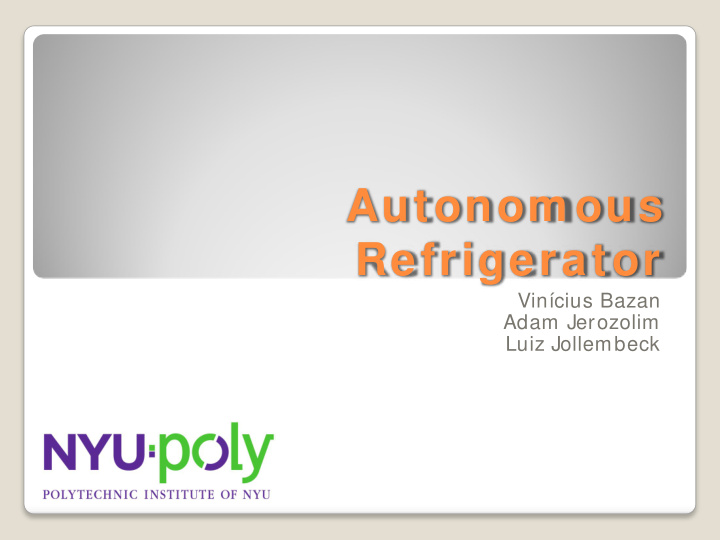



Autonom ous Refrigerator Vinícius Bazan Adam Jerozolim Luiz Jollembeck
I ntroduction Components Circuits Coding Marketing Conclusion I ntroduction
Uses Specimen and Culture Refrigerators can be found in many industries including • Laboratory • University • Research Institution
W hy Use Tem perature Control? Culture Storage Experiment preparation Specimen harvesting Culture Growth Research Environmental Simulation Possibilities
Tem perature Control Draw backs Requires expensive equipment Constant monitoring required Around the clock on-call researcher Need to work around specimen temperature Require constant sample checking Draw backs
I NTRODUCI NG THE AUTONOMOUS REFRI GERATOR ROBOT
Introduction Com ponents Circuits Coding Marketing Conclusion Com ponents
Photoresistor • Variable Resistor • Changes Resistance with light
Therm istor • Variable Resistor • Changes Resistance with Temperature
H- Bridge • Used to control a high current device • Can control current in two directions for Dc motor control
Introduction Components Circuits Coding Marketing Conclusion Circuits
Button Circuit • Vdd pulls the Basic Stamp normally high • The switch is NO • When the button is pressed the pin goes to ground and BS senses it as a low
Parallax LCD • Interacts with the Basic Stamp using only one Pin • Can display information about program selection, can location and temperatures
H- Bridge • Uses 2 BS pins per motor • Isolated BS voltage from external source • External voltage needs to be higher than BS 5v to activate the MOFSETSs
Servo Motors • Can control speed, location and position with one BS pin • Can operate using BS current and voltage
RC Circuit • Used to measure the resistance of a variable resistor with basic stamp • Used for photoresistor and thermistor • Capacitor sizing is used to calibrate the range of resistance
Op- Am p • Used in conjunction with the photoresistor • Sends either Vss or Vdd to BS depending on resistance in the photoresistor • Used to stop the robot quickly on the rails with only a small change in resistance
Introduction Components Circuits Coding Marketing Conclusion Coding
Main • Sets values for important variables • Calls starting functions • Branches to selected option
Start • Shows the options • Asks user to choose one
Option • Reads buttons • Displays the function selected
Check Cans • Detects if there are cans in the positions • Saves positions in variable POSCANS
Arm Dow n/ Up • Controls the DC motor of the arm • Different time if holding can
Close/ Open Claw • PWM pulses to control claw’s servo
Pausesub • Created to make possible the sensing of emergency button while pausing • Pauses for 100 milliseconds and checks button
Get Coldest • Piece of code similar in every function • Checks if current position has can
Get Coldest • After sensing temperature, records it and position if lowest • Variable Temp is related to time of RC circuit. The higher the value, lower the temperature
Get Coldest • Checks if current position is last with cans • If so, goes to pick can routine
Pick Can • Checks if current position is position of coldest can • If so, picks can and goes back to start position
First Cold Can • Similar to get coldest • Gets cold can as soon as it finds it • If none is found displays message
Freezing • Similar to previous • Never gets a can • Shows warn if temperature is below freezing temperature
Introduction Components Circuits Coding Marketing Conclusion Marketing / Conclusion
More compact design can be achieved with better materials All components need to be rated for colder temperatures A larger sample size will need to be able to be observed More precise temperature reading capabilities. I m provem ents
Additional sensors to make possible safe reset: ◦ Claw state ◦ Arm position ◦ End of trail I m provem ents
Sum m ary I ncreased productivity Lower operating costs for labs More precise readings Larger quantities capable of being observed A product no lab w ill be w ithout!!!
Thank you
Recommend
More recommend